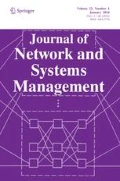Abstract
Network Traffic Management includes all the procedures set up for recognizing and solving traffic anomalies, i.e., any mismatching situation between traffic demand and network capacity that leads to an impairment in network performances. The resolution of traffic anomalies has generally received considerably more attention than the recognition phase. In this paper a diagnostic tool, based on the use of fuzzy logic, is proposed to recognize traffic anomalies (overloads and failures) on the basis of measurements currently available on commercial switches. The tool is composed of five separate inferential blocks, arranged over three hierarchical levels. The probability of correct diagnosis in the two opposite cases of no anomaly and moderate anomaly, evaluated by simulation, is shown to be over 97% for nodes and high usage trunk groups and over 90% for final trunk groups.
Similar content being viewed by others
REFERENCES
L. A. Gimpelson, Network management: Design and control of communications networks, Electrical Communication, Vol. 49, No. 1, pp. 4-22, 1974.
P. J. Burke, Automatic overload control in a circuit-switched communication network, Proceedings of the National Electronic Conference, pp. 667-672, 1968.
J. M. Akinpelu, The overload performance of engineered networks with nonhierarchical and hierarchical routing, Tenth International Teletraffic Congress, Montreal, June 1983.
J. Filipiak, Real time network management, North Holland, 1991.
L. H. Campbell and H. J. Everitt, A layered approach to network management control, Journal of Network and Systems Management, Vol. 1, No. 1, pp. 41-55, March 1993.
ITU-T Recommendation E.410, International network management-General information, Geneva, October 1996.
S. Kheradpir, W. Stinson, J. Vucetic, and A. Gersht, Real-time management of telephone operating company networks: Issues and approaches, Journal on Selected Areas in Communications, Vol. 11, No. 9, pp. 1385-1403, December 1993.
D. G. Haenschke, D. A. Kettler, and E. Oberer, Network management and congestion in the U.S. telecommunication network, IEEE Transactions on Communications, Vol. COM-29, No. 4, pp. 376-385, April 1981.
M. Butt`o and G. Giacobbo Scavo, Network management policies: Which aims and how to pursue them, Proceedings of the Network Management and Control Workshop, Tarrytown, New York, 1989. Also in CSELT Technical Reports, Vol. 18, No. 3, pp. 167-171, June 1990._
Special issue on Advanced traffic control methods for circuit-switched telecommunication networks, IEEE Communication Magazine, Vol. 2, No. 10, 1990.
F. Langlois and J. Regnier, Dynamic congestion control in circuit-switched telecommunication networks, 13th International Teletraffic Congress, Copenhagen, pp. 127-132, June 1991.
R. Warfield and D. McMillian, A linear program model for automation of network management, Journal on Selected Areas in Communications, Vol. 6, No. 4, pp. 742-750, May 1988.
Y. Tanaka, K. Miyakoshi, and M. Akiyama, Dynamic routing by the use of hierarchical fuzzy system, IEICE Transactions, Vol. E74, No. 12, pp. 4000-4005, December 1991.
P. Chemouil, J. Khalfet, and M. Lebourges, A fuzzy control approach for adaptive traffic routing, IEEE Communications Magazine, Vol. 33, No. 7, pp. 70-76, July 1995.
P. Bostica, M. Butt`o, and A. Tonietti, Statistical methods for detecting overloads in a trunk group, Ninth International Teletraffic Congress, Torremolinos, October 1979.
A. Briccoli, Comparison of regulation methods for traffic overloads in SPC systems, Ninth International Teletraffic Congress, Torremolinos, October 1979.
P. Chemouil and D. Stern, A diagnosis expert system for network traffic management, Networks, Kobe (Japan), 1992.
E. Boutleux and B. Dubuisson, Fuzzy pattern recognition to characterize a system evolution. Application to a model of the French telephone network, Annales des Telecommunications, Vol. 51, No. 9-10, pp. 509-520, 1996.
F. Garcia-Ayllon, A. Santos, J. Rodriguez-Molowny, and F. Fernandez, Characterization of network anomalies and their detection, CSELT-Telefonica Joint Group on NTM, Working paper, July 1994.
D. J. Houck, K. Meier-Hellstern, F. Saheban, and R. A. Skoog, Failure and congestion propagation through signaling controls, 14th International Teletraffic Congress, Antibes, pp. 367-376, June 1994.
T. J. Ross, Fuzzy logic with engineering applications, McGraw Hill, 1995.
I. T. Jolliffe, Principal Component Analysis, Springer-Verlag, 1986.
F. Malabocchia, M. Menozzi, M. Negro, P. Panicciari, and M. Paciotto, The network management simulator: Network environment specifications (in Italian), CSELT Technical Reports, December 1990.
E. Didelet, B. Dubuisson, and D. Stern, A neural technique approach to network traffic management, 14th International Teletraffic Congress, Antibes Juan-les-Pins (France), pp. 1321-1330, June 1994.
B. Eklund and D. Rapp, Load study of the AXE10 Control System, Ericsson Review, No. 4, 1982.
Author information
Authors and Affiliations
Corresponding author
Rights and permissions
About this article
Cite this article
Buttò, M., Naldi, M. & Neri, A. Fuzzy Logic-Based Diagnosis of Traffic Anomalies in Voice Networks. Journal of Network and Systems Management 9, 161–182 (2001). https://doi.org/10.1023/A:1011363008770
Issue Date:
DOI: https://doi.org/10.1023/A:1011363008770




